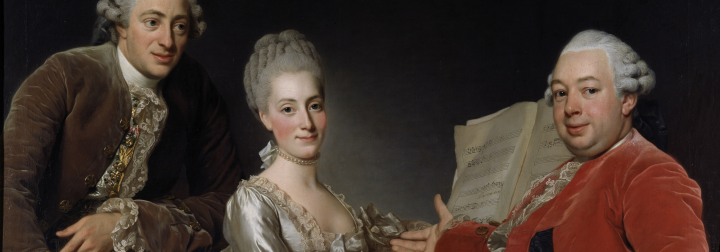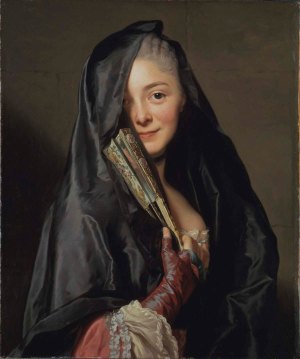Exhibition | Alexander Roslin: Portraitist of the Aristocracy

Alexander Roslin, John Jennings Esq., with His Brother
and Sister-in-Law, detail (Stockholm: Nationalmuseum)
◊ ◊ ◊ ◊ ◊
From the Rijksmuseum Twenthe:
Alexander Roslin: Portraitist of the Aristocracy / Portrettist van de aristocratie
Rijksmuseum Twenthe, Enschede, The Netherlands, 18 October 2014 — 12 April 2015
Beauty, wealth, power and prestige: the Swedish painter Alexander Roslin had an unerring grasp of how to portray the ruling class of his time. As a travelling portraitist in the second half of the eighteenth century, he visited the European centres of power to portray kings, queens and other members of the aristocracy and nobility in their finest dress. The exhibition, Alexander Roslin (1718–1793). Portraitist of the Aristocracy gives a wonderful overview of a turning point in history. The portraits of Roslin are personal documents of a period that is coming to an end, one of limitless power, extreme poverty, of beauty and atrocity. It was perhaps a tense and nervous time in modern history, which fell like a house of cards and changed Europe forever.
Le Chevalier Roslin, as he was sometimes known, immortalised the ruling class at the height of its wealth and power. He was the chronicler of the wealth and decadence of the late eighteenth century. But this ‘pageant’ was with hindsight the last spasm of a class that would soon lose its power and prestige. These were turbulent times: political and social unrest prevailed, which reached its climax with the outbreak of the French Revolution in 1789. Many aristocrats who were painted by Roslin lost then their high positions and corresponding status. Some even literally lost their head under the guillotine or died a violent death through other means. The fact that Roslin himself, as representative of the hated ruling class of the Ancien Régime, miraculously survived the Revolution is probably due to his not being a French citizen.
This first Roslin exhibition in the Netherlands is not only a unique opportunity for the Dutch public to get to know the wonderful work of Alexander Roslin, but it also draws the visitors into the world of the aristocrats he portrayed. Their fascinating stories, which were sometimes dramatic and always personal, and which included political and moral intrigues, form the thread which guides the visitor through this exhibition. The luxury in which the portrayed class lived and the sweeping changes they encountered in their world are brought to life by objects from their entourage: costumes, furniture and porcelain, but also letters and prints. An intriguing picture is given of a class and way of life which experienced its climax in Roslin’s time, just before its downfall. In this way we get close to the artist and his clientele.
The exhibition will show in total more than thirty works from different international collections. Rijksmuseum Twenthe is the only museum in the Netherlands which has two portraits by Roslin in its museum collection. The delicately painted and elegant portraits of the French couple Marie Romain Hamelin and Marie Jeanne Puissant represent a type of painting that is unique in Dutch museum collections.
Especially for this exhibition RMT will have no less than sixteen top artworks on loan from the Roslin collection of the Nationalmuseum in Stockholm, including Portrait of Gustave III and the Lady with the Veil, which was described by the famous French author and critic Denis Diderot as ‘très piquante’. From the collection of the Nationalmuseum there will also be portraits on show of the Swedish Royal family, such as those of the Swedish king Gustav III (1775) and of his dominant mother Lovisa Ulrika, princess of Prussia, queen of Sweden (also 1775). Members of the French Royal family and others associated with the Roi, including Louis-Philippe de Bourbon (1725–1785), duke of Chartres, later duke of Orleans also figure prominently in the exhibition. The aristocracy is well represented in the exhibition, with wonderful portraits of the Baron and Baroness de Neubourg-Cromière (1756). One of the highlights of the exhibition is the dual display of the portrait of Princess Hedvig Elisabet Charlotta of Sweden and the original bridal dress which she is wearing on her portrait.
This exhibition has been made possible through the generous support of: Nationalmuseum Stockholm, Friends of the Rijksmuseum Twenthe, the Prins Bernhard Cultuurfonds (Nieske Fonds), Mondriaan Fund, VSB Fund, SNS Reaal Fund.
400 Years of Friendship between Sweden and the Netherlands
In 1614 Sweden opened in the Netherlands its first-ever embassy. This was the start of a friendship which has enriched and continues to enrich our economies and societies to the present day. In 2014 we’re celebrating this friendship through a special activity programme. The exhibition Alexander Roslin: Portraitist of the Aristocracy is part of an international programme. Look for more information on www.swe400nl.com.





























leave a comment